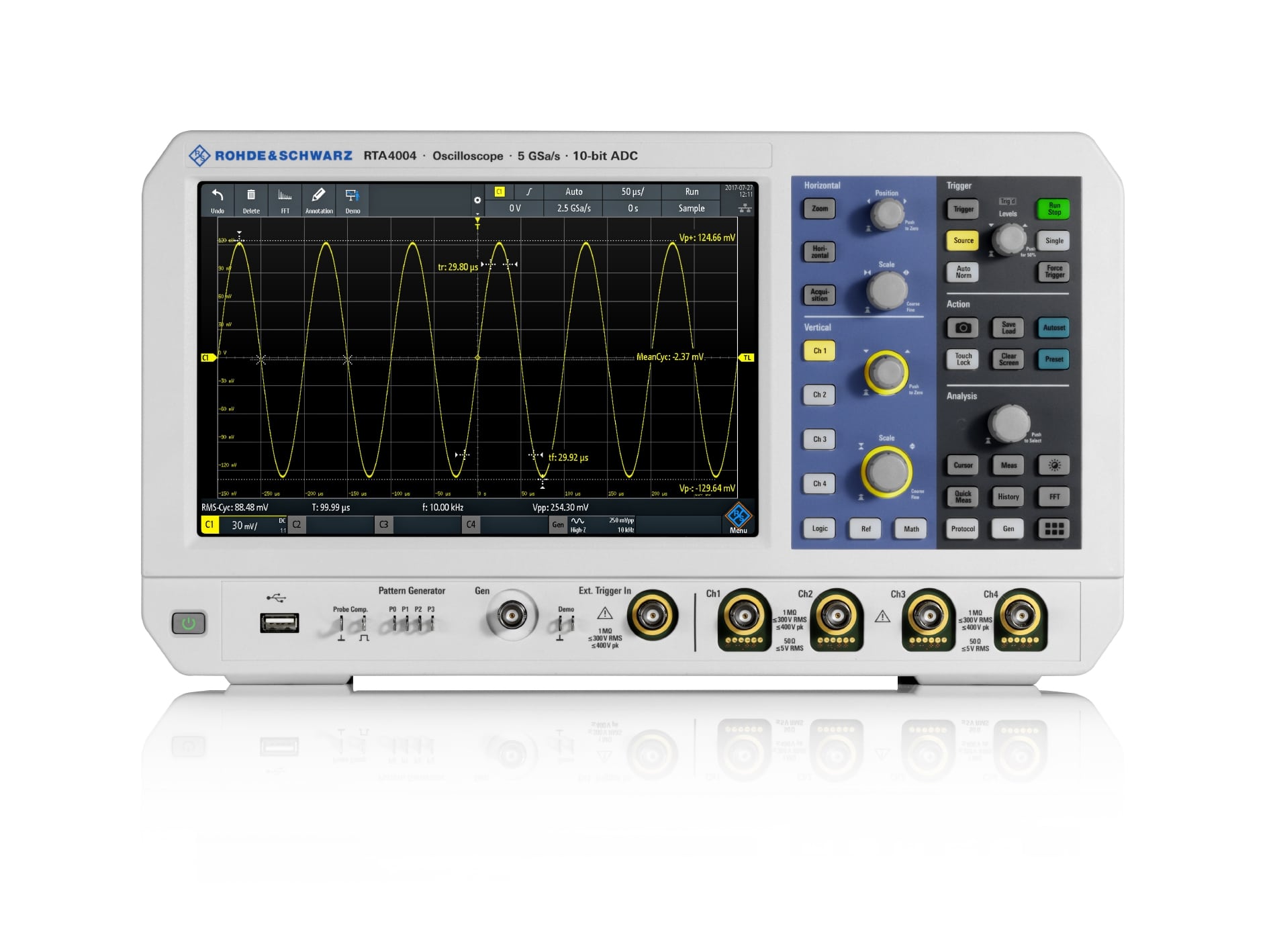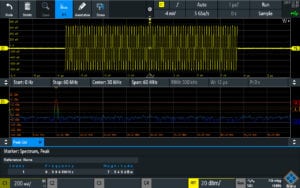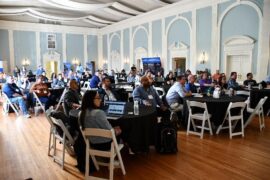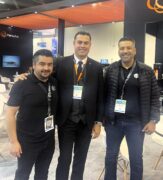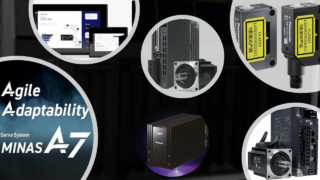Engineers continue to rely on oscilloscopes as a primary tool for testing and debugging electronic designs. Development teams need oscilloscopes that capture more time, have increased vertical resolution, incorporate increased functionality, are easy to operate, and fit within constrained budgets. To address these needs, Rohde & Schwarz introduced the R&S RTM3000 and R&S RTA4000 series oscilloscopes that complement the R&S RTB2000 series introduced in 2017. Models are available in bandwidths ranging from 100 MHz to 1 GHz. What’s different about the new oscilloscopes versus others in the market? Deeper memory and increased vertical resolution are two key attributes.
Acquisition memory determines how much time an oscilloscope can capture. Oscilloscopes that compete against the R&S RTM3000 and R&S RTA4000 generally have between 4 Msample and 20 Msample acquisition memory, and some do not offer segmented memory. Engineers at Rohde & Schwarz took a different approach and incorporated significantly more memory for capturing events that take longer time, such as power-up and power-down sequences. R&S RTM3000 models come standard with 40 Msample acquisition memory (80 Msample interleaved) while R&S RTA4000 models come with 100 Msample (200 Msample interleaved). Increased acquisition memory sizes allow engineers to retain fast sample rates while capturing longer time periods.
Segmented memory is a mode where the oscilloscope allows the user to partition acquisition memory into multiple segments. On each trigger event, the oscilloscope captures a certain amount of memory around the trigger event. The R&S RTA4000 oscilloscope comes standard with 1 Gsample segmented memory, 250 times more than leading scopes in this product category. R&S RTM3000 models have a segmented option with 400 Msample memory. Segmented memory can be particularly useful for bursty signals such as serial buses or RF communications, as no memory is used during periods of signal inactivity.
Low noise coupled with additional vertical resolution enables oscilloscopes to see signal details that can be missed by other oscilloscopes. Both the R&S RTM3000 and the R&S RTA4000 series incorporate a 5 Gsample/s sample rate enabled by company-proprietary 10-bit A/D converters (ADC). 10-bit ADCs have 1024 quantization levels, four times more than the 256 quantization levels associated with traditional 8-bit ADCs. In addition, both new oscilloscope series feature a low-noise frontend that retains full oscilloscope bandwidth all the way down to 1 mV/div sensitivity. The additional signal detail is useful for applications such as power electronics and power integrity measurements where users need to see small signal changes.
Both instrument series feature a brilliant 10.1” capacitive touchscreen display to operate quickly and efficiently. They are highly portable and provide a boot-up time of 10 seconds. Each model includes a LAN interface. Simply type in the oscilloscope IP address in a web browser and you are connected to get screenshots, show the live scope display, use remotely the front panel, and have full SCPI device control from within the browser.
Having the right probe is critical for most applications. The new oscilloscopes support a wide variety of passive and active probes, current and voltage probes, single-ended and differential probes, including four new R&S RT-ZHD high-voltage differential probes. The new CAT III high-voltage differential probes come in either 100 MHz or 200 MHz bandwidth, allow input voltages up to 6000 V, provide up to 2000 V offset compensation and have a high common mode rejection ratio of 80 dB from DC to 60 Hz. For power electronic applications, the probes make a nice companion to the oscilloscopes.
Unique to the industry, these oscilloscopes incorporate the USB-based connectivity standard media transfer protocol (MTP), the same standard that allows mobile phones to connect to PCs. It allows users over a USB host connection on the rear of the scope to effortlessly retrieve a file with the oscilloscope’s current display image or export oscilloscope waveform data for post analysis (e.g. Excel).
The new oscilloscope series offer users a variety of tools to assist in testing and debugging. Not only are the oscilloscopes highly capable, users also have access to additional instrument functionality built into the products.
Standard tools• FFT (see Fig. 1)
• Mask testing
• XY mode
• DC meter
• Counter
Options
• Protocol triggering and decode options for I2C, SPI, UART, RS-232, LIN, CAN, MIL-STD 1553, ARINC 429 and I2S
• MSO option (adds 16 digital channels)
• Waveform generator for signal creation
• 4-bit pattern generator
• Spectrogram option (see Fig. 2) for viewing time-varying RF signals such as signal hopping
• Power analysis
The R&S RTM3000 and the R&S RTA4000 oscilloscopes are now available from Rohde & Schwarz and selected distribution channel partners. R&S RTM3000 models start at $3,555 while R&S RTA4000 models start at $5,940.
Fig. 1: The new Rohde & Schwarz oscilloscopes include an FFT standard allowing time-correlated time and frequency domain measurements.
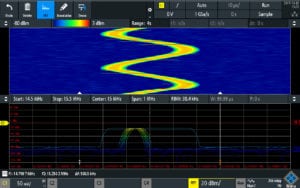
Fig. 2: A spectrum mode and spectrogram option supports viewing time-varying RF signals, such as hopping, with a spectrogram.


